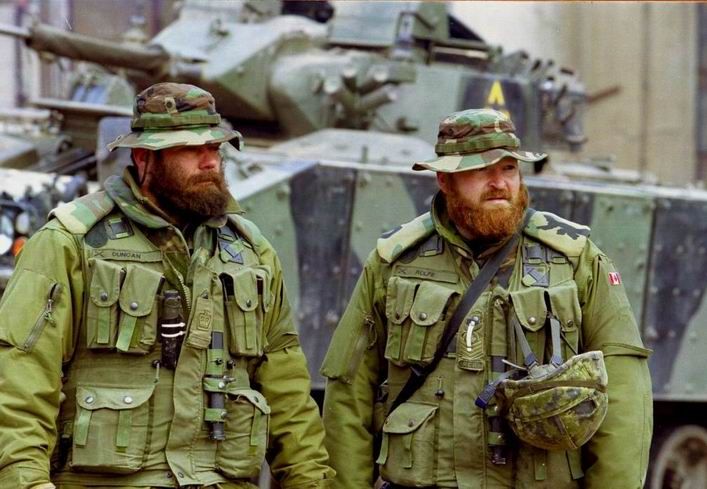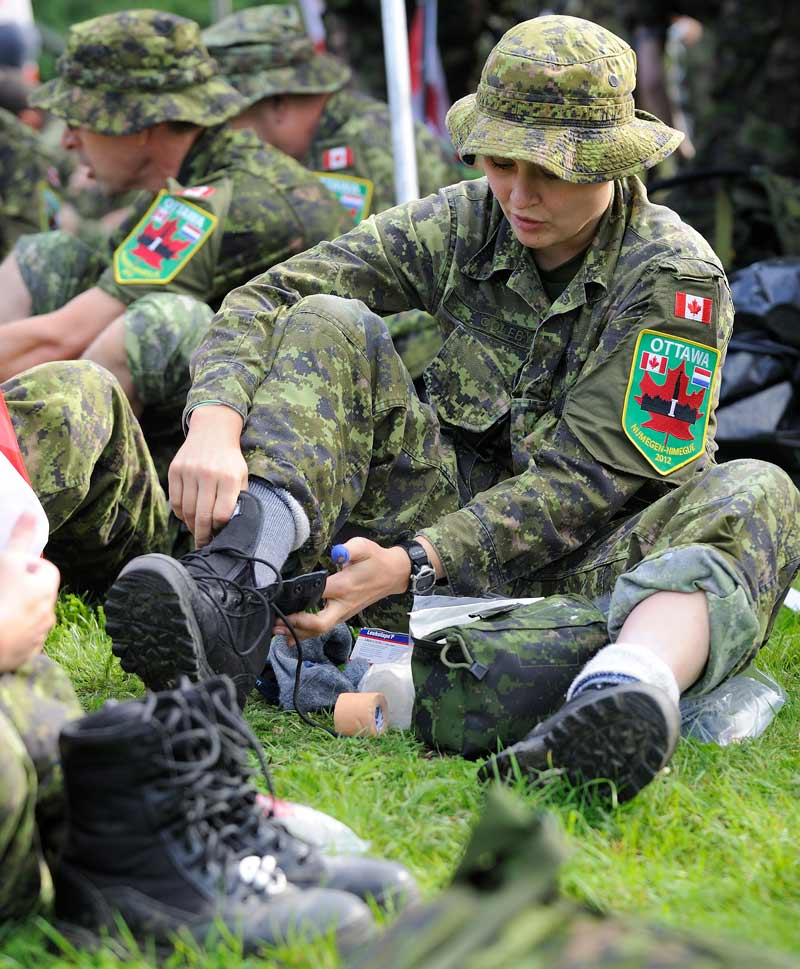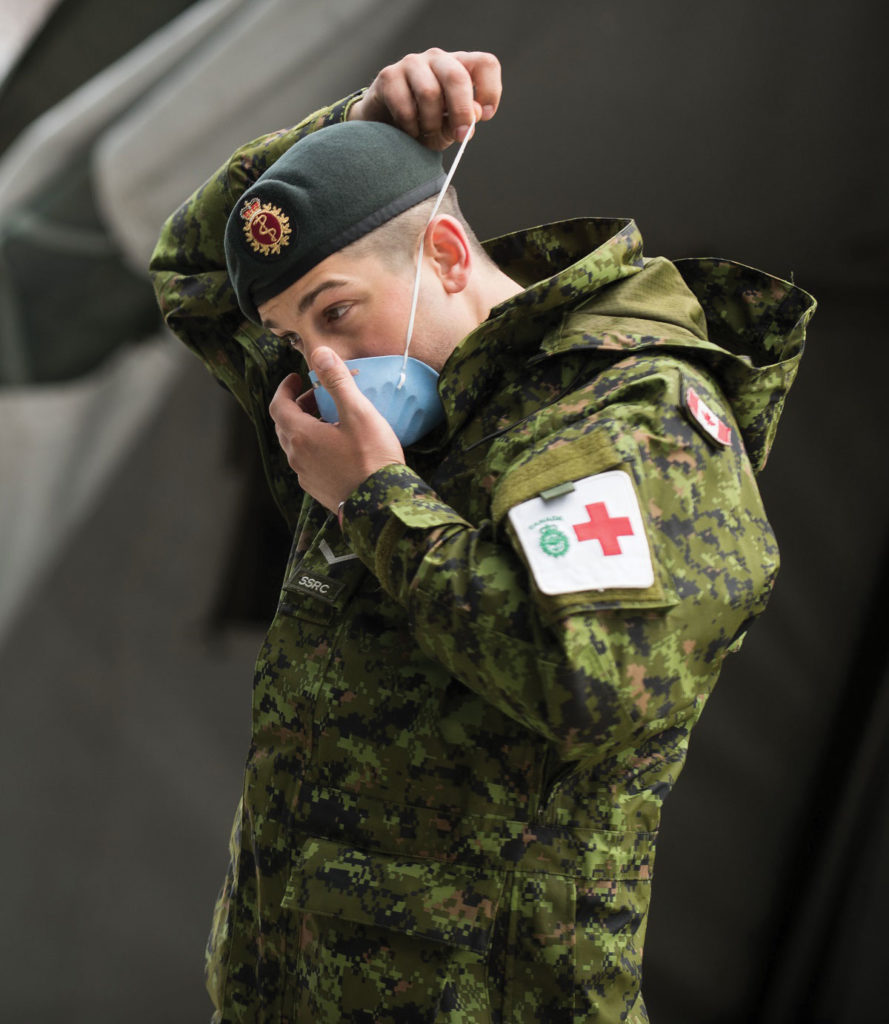
Two Canadian assault pioneers with the NATO force in Kosovo in 1999. Until now, pioneers, special forces and sailors at sea were the only elements of the Canadian military permitted to wear facial hair. [DND]
That means traditional short hair is out—unless you prefer it that way. Soldiers, sailors and aircrew can now grow their manes as long and in whatever colour they want, provided they don’t cover their faces or impede operational performance.
“The colour and the length of your hair does not define your quality as a soldier and aviator and sailor.”
“We cannot define our soldiers by short hair anymore,” said Major-General Lise Bourgon, acting chief of military personnel. “The colour and the length of your hair does not define your quality as a soldier and aviator and sailor. So, this is a big departure.”
Military personnel of all genders can also now sport tattoos, wear most piercings, apply cosmetics, fashion false nails and choose whatever military clothing suits their taste—except where it’s operationally unsafe. The primary other restrictions under the new dress regulations apply to formal ceremonies, for which parade commanders will continue to dictate what’s acceptable.
“The changes eliminate binary choices by allowing members the freedom to choose the uniform that makes them most comfortable,” said Bourgon.
There’s even a regulation for backpacks: they can be worn slung over both shoulders, or just the left one, leaving the right arm free to salute.
The changes come as the military faces a recruitment crunch. It’s short about 4,000 regular members and 6,000 primary reservists under its current authorized strength of 99,000, which is to be increased by 2,500 in the next four years.“The bottom line is that diversity enhances readiness and, in turn, our operational effectiveness.”
The Forces are currently about 71 per cent white men. That contrasts with a civilian workforce that is 39 per cent Caucasian male.
Women and racialized Canadians have been prioritized in what has so far been a recruitment campaign fraught with challenges and setbacks that include continuing issues surrounding sexual misconduct at even the CAF’s most senior ranks, and the involvement of some military members in white nationalist causes and groups.
“The bottom line—and truly the bottom line—is that diversity enhances readiness and, in turn, our operational effectiveness,” Bourgon recently told The Canadian Press. “As an organization, we must attract, recruit, retain and develop talent that is representative of our Canadian society.”
Despite a long history of women on the front lines that spans Viking times to the Soviet Red Army of the Second World War, Canadian women didn’t see their first combat roles until the Persian Gulf War in 1990-91.
And that was considered by many to be ahead of its time. It was not until 2011 before Australia opened its combat trades to women. The United States didn’t do so until 2013.
While racial segregation was the norm in many western militaries as recently as the Second World War, integration was more common than one might have expected in the uniformed services of the British Empire and earlier.
Recent research on remains and artifacts from the recovered wreck of the Tudor warship Mary Rose reinforced Britain’s long history as a society of multiple races and ethnicities.
Isotope analysis helped construct what one expert described as “unparalleled” biographies suggesting several of the tested subjects were raised on African, Mediterranean, or other diets—markedly differing fare from the bread, soups, stews, ale and meats on which most 16th-century Britons relied.
Head-shaving has for decades constituted an almost-ritualistic entry into the armed forces of Canada and the U.S.
Hair and the military have had a strained relationship ever since Alexander the Great insisted his troops shave their beards to avoid giving their enemies something to grab on to in close-quarters combat.
Roman legionnaires wore their hair notably short, but in his book Ancient European Costume and Fashion, author Herbert Norris writes that men wore their hair short throughout the whole period of the Roman empire anyway.
“The maximum length of locks being from one and a half to two inches and varying at times from almost a close crop to wavy curls.”
Head-shaving has for decades constituted an almost-ritualistic entry into the armed forces of Canada and the U.S., a favoured war movie moment where young punks begin their transition into military manhood surrounded by softly falling locks. The practice will no longer be a part of Canada’s military induction regimen.
Sideburns, beards, moustaches and goatees, or any combination thereof, is open now from recruitment to release. There is no maximum or minimum length. Only that hair must be neatly groomed and symmetrical, safe and operationally compatible.
“Short hair has been a military standard for ‘the same reason they are wearing clothes that all look the same: uniformity.”
Author Roland Bartetzko, a convicted terrorist and former soldier who fought with the Croatian Defence Council in the Bosnian War and the Kosovo Liberation Army in the Kosovo War, says short hair has been a military standard for “the same reason they are wearing clothes that all look the same: uniformity.”
“The main thing is that a uniform haircut, combined with uniform clothing, movements, language, etc., help transform an individual (civilian) into a working part of a big machine (the military),” he told an online discussion group.
But Bartetzko, a German who served prison time for a fatal 2001 car-bombing in Pristina, notes that there are also practical reasons for short hair in the military: it requires less water, soap and maintenance; it’s less vulnerable to disease and lice; headwear and gas masks fit better; and it’s more amenable to hot weather.

Corporal Jill Coleby replaces her boots after a break during the Nijmegen Marches in the Netherlands. The march took place from July 17-20 in 2012. [MASTER CORPORAL SHILO ADAMSON/COMBAT CAMERA/DND]
“The decision to update the Canadian Forces Dress Instructions was not made lightly,” said a Defence Department statement. Discussions involved defence advisory groups, gender advisors and current military members, along with “the next generation of Canadians who will follow us.”
“The bottom line is, the Canadian Forces Dress Instructions are about 50 years old and so the policy as a whole was overdue for revision. The appearance of the Canadian Armed Forces has not kept pace with the Canadian society which it serves.”
Advertisement






















